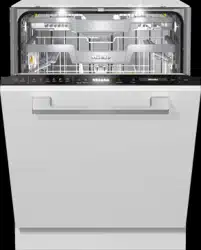Documents: Go to download!
User Manual
- User Manual - (English)
- Warranty conditions - (English)
- Mounting plan - (English)
- Guide to the appliance
- Before using for the first time
- Settings
- Loading the dishwasher
- Operation
- Options
- Cleaning and care
- Frequently asked questions
Table of contents
User manual Dishwasher
Guide to the appliance
Machine overview
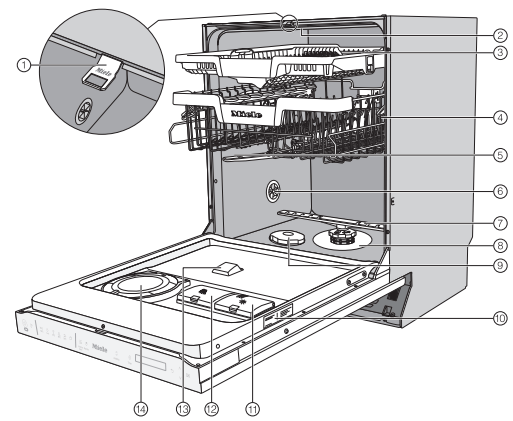
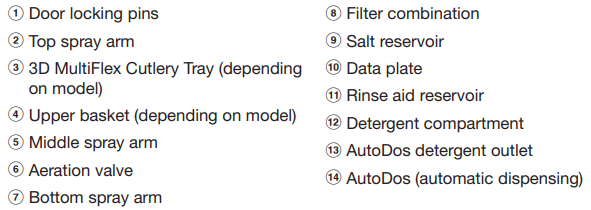
Control panel
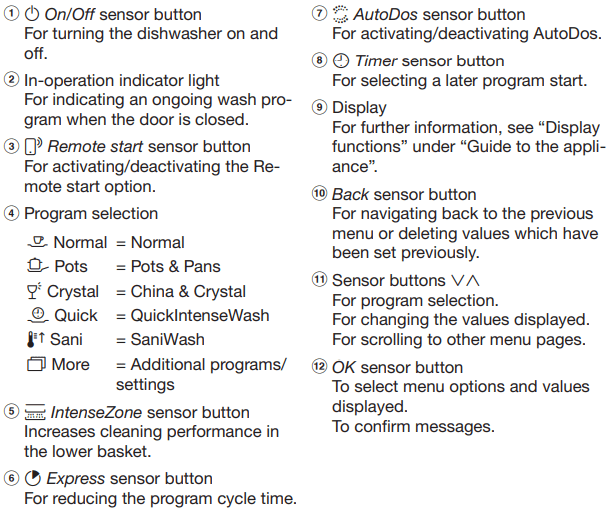
Before using for the first time
Rinse aid
Rinse aid is necessary to ensure that water does not cling and leave marks on dishes during the drying phase, and helps dishes dry faster after they have been washed.
Rinse aid is poured into the container and the amount set is dispensed automatically.
Adding rinse aid
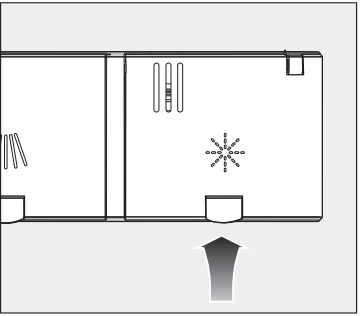
- Press the yellow button
 on the lid of the rinse aid reservoir.
on the lid of the rinse aid reservoir.
The lid will spring open.
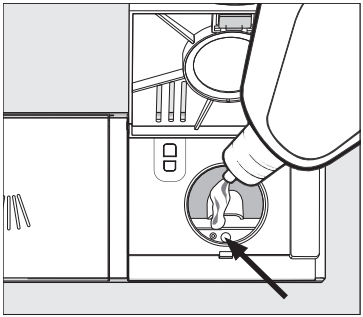
- Fill with rinse aid until the filling level indicator (arrow) changes to a dark color while the door is horizontally open.
The rinse aid reservoir holds approximately 110 ml.- Close the lid firmly until you hear it click into place. Otherwise, water can enter the rinse aid reservoir during a program.
- Wipe up any spilled rinse aid. This prevents excess foam developing during the next program.
You can adjust the rinse aid dosage for best wash results (see “Rinse aid” under “Settings”).Filling the rinse-aid reservoir
When  Add rinse aid appears in the display, the reservoir contains sufficient rinse aid for 2–3 programs only.
Add rinse aid appears in the display, the reservoir contains sufficient rinse aid for 2–3 programs only.
- Add rinse aid in plenty of time.
- Confirm with OK.
The rinse-aid refill indicator will go out.
You can alter the dishwasher’s controls to suit changing requirements by adjusting the settings.
The settings can be altered at any time.Settings
Opening the settings menu
- Turn the dishwasher on with the
 sensor button if it is turned off.
sensor button if it is turned off. - Touch the
 “Additional programs/ Settings” sensor button.
“Additional programs/ Settings” sensor button.
The first of the additional programs will appear in the display.
- Use the
 sensor button to select the Settings
sensor button to select the Settings  menu option and confirm with OK.
menu option and confirm with OK.
The first option in the Settings menu will appear in the display.
For further information about the display functionality, see “Display functions” under “Guide to the appliance”.Changing settings
Use the  sensor buttons to select the menu option you want to change and confirm your selection with OK.
sensor buttons to select the menu option you want to change and confirm your selection with OK.
Sub-menu options that have already been selected will have a check  beside them.
beside them.
- Select the setting you want using the
 sensor buttons and confirm with OK.
sensor buttons and confirm with OK. - To exit a sub-menu again, use the Back sensor button.
The display will revert to the menu above.
Closing the settings menu
- Touch the Back sensor button.
The display will change to the  More menu.
More menu.
Language 
The display can be set to appear in one of several different languages.
You can change the language used in the display and also the country via the Language  sub-menu.
sub-menu.
The flag after the word Language  serves as a guide if a language that you do not understand has been set. In this case keep selecting the menu option that has a flag after it until you reach the Language
serves as a guide if a language that you do not understand has been set. In this case keep selecting the menu option that has a flag after it until you reach the Language  sub-menu.
sub-menu.
Time of day
The current time of day must be set before you can use the timer option.
Setting the clock format
You can select either a 24-hour or 12- hour clock.
- Select the Clock format menu option.
- Select the setting you want and confirm with OK.
Setting the time
You can set the current time of day.
- Select the Set menu option.
- Use the
 sensor buttons to enter the hour and confirm your entry by touching OK. Then set the minutes and confirm with OK.
sensor buttons to enter the hour and confirm your entry by touching OK. Then set the minutes and confirm with OK.
The time of day has now been saved.
AutoDos (AutoDos)
AutoDos automatically adjusts the amount of detergent to the selected program. In the Auto program, the quantity is adjusted depending on the degree of soiling of the dishware.
If you want to extend the service life of the PowerDisk, you can reduce the dispensing quantity. The program’s cleaning performance may decrease as a result.
If you want to improve the cleaning performance, you can increase the dispensing quantity. This reduces the service life of the PowerDisk.
Setting the Dosage amount
For best results, you can adjust the dispensing quantity of the PowerDisk.
- Select the Dosage amount menu option and confirm with OK.
- Select the setting you want and confirm with OK.
Rinse Aid
You can adjust the rinse aid dosage for best results.
The rinse aid dosage can be set from 0 to 6 ml.
3 ml is the factory default setting.
The rinse aid dosage can turn out to be higher than the set value due to the automatic adjustment of the program.
If spots appear on dishes and glassware:
- Increase the rinse aid dosage.
If clouding or smearing appears on dishes and glassware:
- Decrease the rinse aid dosage.
Remote control
This menu option will only be displayed if you have connected your dishwasher to your WiFi network (see “Miele@home” under “Settings”).If you wish to permanently turn off the Remote control option, you can do this under this menu option. The  sensor button will then no longer be available to select until you change this setting again.
sensor button will then no longer be available to select until you change this setting again.
Even if the Remote control option is turned off, you can use Miele to call up information about your appliance. However, you cannot start any programs or change any settings from it.
RemoteUpdate
The RemoteUpdate menu option is only displayed and can only be selected if the requirements for using Miele@home have been met (see “Miele@home” under “Before using for the first time”).The RemoteUpdate function is used for updating the software in your dishwasher. If an update is available for your dishwasher, it will automatically download it. Updates will not be installed automatically. They must be initiated manually.
If you do not install an update, you can continue to use your dishwasher as usual. However, Miele recommends installing updates.
Activating/deactivating
The RemoteUpdate function is activated as standard. Available updates will be downloaded automatically but will only be installed if you initiate installation manually.
Deactivate RemoteUpdate if you do not want any updates to be downloaded automatically.
Running RemoteUpdate
Information about the content and scope of a RemoteUpdate will be provided in the Miele app.A message will appear in your dishwasher display if a software update is available.
You can install the update immediately or postpone this until later. When the appliance is turned on again, you will be reminded about the update.
Deactivate RemoteUpdate if you do not want to install the update.
The update may take several minutes.Please note the following information about the RemoteUpdate function:
- You will only receive a message when an update is available.
- Once an update has been installed, it cannot be undone.
- Do not turn the dishwasher off during the update. Otherwise, the update will be aborted and will not be installed.
- Some software updates can only be carried out by Miele Customer Service.
SmartStart
This menu option will only be displayed if you have connected your dishwasher to your WiFi network (see “Miele@home” under “Settings”).The SmartStart function is used for starting your dishwasher automatically at a time when your energy costs are most economical.
To use this function you may need further technical accessories.
If you have activated SmartStart Permitted, the Timer  menu of the selected program will no longer show EcoStart but will instead show SmartStart. The dishwasher will then start within the timeframe specified when it receives a signal from the energy supplier. If it has not received a signal from the energy supplier by the latest possible start time, the dishwasher will start automatically
menu of the selected program will no longer show EcoStart but will instead show SmartStart. The dishwasher will then start within the timeframe specified when it receives a signal from the energy supplier. If it has not received a signal from the energy supplier by the latest possible start time, the dishwasher will start automatically
Volume
A sequence of audible signals will sound at the end of the program or if there is a fault, provided that the audible signals have been activated.
Audible signals in the event of a fault
In the event of a fault, the alarm tone will sound 4 times at intervals with a short pause between each set of tones.
The alarm tone that sounds when there is a fault cannot be deactivated.Audible signals
The audible signals at the end of a program will sound 4 times at intervals with a short pause between each signal.
The volume of the audible signals at the end of the program can be set to one of 7 different settings. If no volume is selected, the audible signals are turned off.
Keypad tone
An audible tone sounds each time a sensor button is pressed.
The volume for the keypad tone can be set to one of 7 different settings. If no volume is selected, the keypad tone is turned off (except the  On/Off sensor button).
On/Off sensor button).
Welcome melody
If you turn the dishwasher on or off, a brief melody will sound.
You can turn the melody off.
Extra Clean
You can choose this function to increase the cleaning performance of the programs.
If you activate this function, the program cycle times and the main wash temperatures will increase. The water and energy consumption may increase.
If this function is turned on, it will be applied to all programs until it is turned off again.
Extra Dry
You can select this function in order to increase the program drying performance.
If you activate this function, the program cycle times and final rinse temperatures will increase. The energy consumption may increase.
If this function is turned on, it will be applied to all programs until it is turned off again.
2nd interim rinse
You can choose this function to increase the cleaning performance of the programs with a second interim rinse.
When this function is activated, water consumption may increase.
If this function is switched on, it will be applied to all programs until it is switched off again.
Hygiene cycle
If you mainly use low-temperature programs , there is a risk of bacteria and unpleasant odors building up in the wash cabinet (see “Hygiene cycle” under “Cleaning and care”).
If this function is switched on, a message will be displayed recommending the use of a high-temperature program after several low-temperature programs have been run.
Loading the dishwasher
General information
Remove coarse food residues from dishes.
There is no need to pre-rinse items under running water.
Dishes can be loaded anywhere in the baskets, but the following notes should be observed:
- Do not place dishes and utensils inside other items where they will cover one another.
- Load the dishes so that water can access all surfaces. This ensures that they get properly cleaned.
- Make sure that all items are securely positioned.
- Hollow items such as cups, glasses, pans, etc., must be inverted in the baskets.
- Tall, narrow, hollow items such as champagne glasses should be placed in the center of the basket rather than in the corners. This ensures the hollow items are more easily accessed by the water jets.
- Concave items such as mugs or bowls should be placed at an angle so that the water can run off.
- The spray arms must not be blocked by items which are too tall or hang through the baskets. Test for free movement by manually rotating the spray arms.
- Make sure that small items cannot fall through the holders in the baskets.
Small items such as lids should therefore be placed in the 3D MultiFlex Tray or cutlery basket (depending on model).
Some foods such as carrots, tomatoes, or ketchup may contain natural dyes. These dyes can discolor plastic items in the dishwasher if large quantities of these foods are in contact with the dishes inside the machine. The stability of plastic items is not affected by this discoloration.
Washing silverware can also cause plastic items to discolor.Wash items not suitable for dishwashers:
- Wooden cutlery and dishes or items with wooden parts. These may discolor and fade. The glue used in these items is not dishwasher-proof and wooden handles may come loose after being washed in a dishwasher.
- Craft items, antiques, valuable vases, and decorative glassware. Such items are not suitable for dishwashers.
- Plastic items that are not heat resistant. The high temperatures in the dishwasher may cause them to melt or lose shape.
- Copper, brass, tin and aluminum items. These may discolor or become dull. - Colors painted over a glaze. These may fade after a number of washes.
- Delicate glassware and glassware containing lead crystal. Clouding may occur over time.
Silver
Silver that has been in contact with foods containing sulphur can discolor. These include egg yolk, onions, mayonnaise, mustard, fish, and marinades. Silverware previously cleaned with a silver polish may still be damp or spotted at the end of a program, where water has not run off smoothly.
Tip: Rub the silver dry with a cloth.
Tip: When purchasing new dishes and cutlery, make sure they are dishwasherproof if you want to wash them in the dishwasher.
Glass care
- Clouding may occur on glasses after frequent washing in the dishwasher. When washing delicate glassware in the dishwasher, ensure that only a special glass-care program with very low temperatures is selected (see “Program overview”). This will reduce the risk of clouding.
- Purchase glassware that is dishwasher-safe (e.g., Riedel glassware).
- Use detergents with glass protective additives.
Loading examples
Loading for 10 standard place settings with cutlery tray
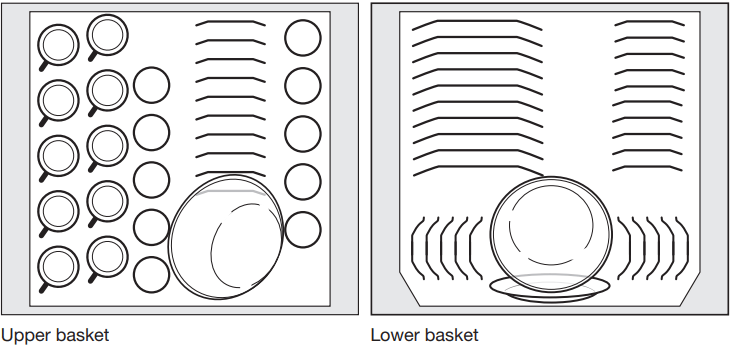
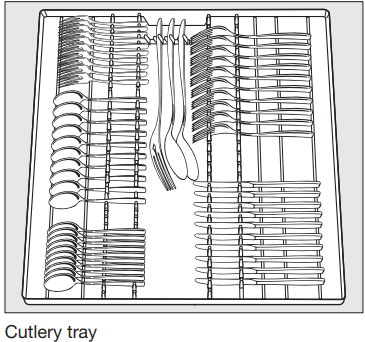
Loading for 16 standard place settings with cutlery tray
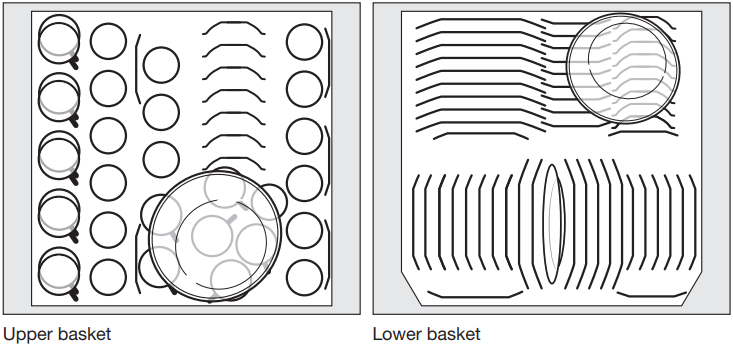

Upper basket
Loading the upper basket
- Use the upper basket for small, lightweight, and delicate items such as cups, saucers, glasses, dessert bowls, etc.
Shallow pans or casserole dishes can also be placed in the upper basket.
- Long items such as soup ladles and mixing spoons should be placed lying down across the front of the upper basket.
Loading the FlexCare cup rack
You can put cups, small bowls, and flat dishes on the FlexCare cup rack. Glasses can be arranged along the cup rack so they sit securely during the program.

- Lower the cup rack to do so.
- Raise the cup rack upwards to make room for tall items.
Adjusting the FlexCare cup rack
You can set the height and depth of the cup rack at 2 different levels so that it can accommodate larger cups and so that taller items can be placed underneath it.
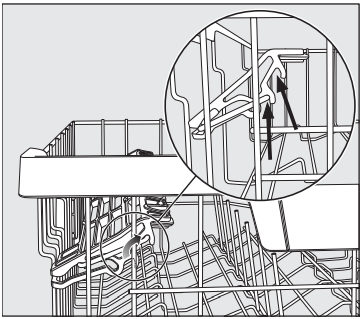
- Pull the cup rack upwards and click it into the desired position (see arrow).
Loading the silicone elements of the FlexCare cup rack
The silicone elements in the cup rack are specially designed to hold tall glasses with long stems securely.
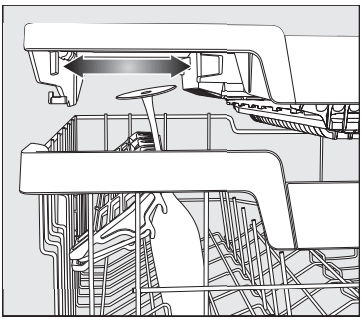
- Lower the cup rack and lean the glasses against the openings.
- If you wish you can adjust the left insert of the 3D MultiFlex Tray to make space for taller glasses (see “3D MultiFlex Tray” under “Cutlery”).
Lowering the spikes
On both right-hand rows of spikes, you can lower every other spike to make it easier to arrange larger dishes, like cereal bowls.
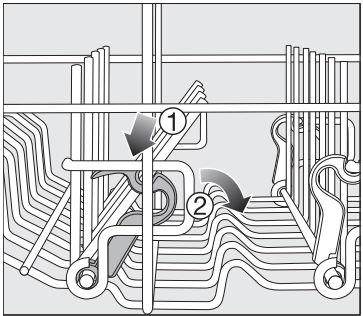
- Press the yellow lever downwards
 , and then lower the dark gray spikes
, and then lower the dark gray spikes  .
. - Place the bowls vertically in the row of spikes.
Operation
Turning on the dishwasher
- Turn on the water supply if it is turned off.
- Open the door.
- Make sure the spray arms can rotate freely.
- Touch the
 sensor button.
sensor button.
If the dishwasher has been turned off for longer than 1 minute, you will need to hold the  sensor button for a bit longer (wipe protection).
sensor button for a bit longer (wipe protection).
The program selected will appear in the display briefly and the indicator light for the program selected will come on. Then the display will show the estimated duration for the selected program.
Selecting a program
Choose your program according to the type of load and the degree of soiling.
The different programs and their uses are described under Program overview.
- Touch the sensor button for the required program.
The sensor button for the selected program will light up.
Additional programs can be selected under  More.
More.
- To do so, touch the
 More sensor button.
More sensor button.
The first of the additional programs will appear in the display.
- Use the
 sensor buttons in the display to select the program you want.
sensor buttons in the display to select the program you want.
You can now select program options (see “Options”).
If any program options are selected, the appropriate sensor buttons will also light up.
If you want to control the dishwasher remotely using the Miele app, you will first need to activate the Remote start option (see “Activate Remote start” under “Options”).
- Close the door within 4 seconds.
Display of program duration
The estimated duration of the selected program appears on the display before the program begins. If the door is opened during the program, the time left until the end of the program is displayed.
Each program phase is indicated by a symbol:
 Pre-rinse/Soak
Pre-rinse/Soak
 Main wash
Main wash
 Interim rinse
Interim rinse
 Final rinse
Final rinse
 Drying
Drying
 Finish
Finish
The displayed duration may vary for the same program. It is influenced by, for example, the temperature of the incoming water, the reactivation cycle of the water softener, the detergent type, and the amount of dishes and how soiled they are.
When a program is selected for the first time, the display will show the average program duration for a cold water connection.
The program durations shown under “Program overview” refer to standard test loads and temperatures.
Each time a program is run, the control module calculates the program duration required depending on the temperature of the water taken into the dishwasher and the amount of dishes.
Starting a program
- Start the program by closing the door within 4 seconds of the last press of a button.
If necessary, confirm the previously displayed message with OK.
The in-operation indicator comes on to show that a program has been started.
If you do not close the door within 4 seconds, the message Continue with OK will appear in the display.
The program cannot be started until you confirm the message by pressing the OK button and close the door within 4 seconds.During a program sequence, you can use OK to display the name of the program that is currently running when the door is open.Risk of scalding due to hot water. During operation, water in the dishwasher may be very hot. During operation, only open the door with extreme caution.End of program
At the end of a program, the in-operation indicator light will be flashing slowly with the door shut. The audible signal may also be sounding.
The in-operation indicator light will go out 10 minutes after the end of the program if the door is closed.
The program has ended when the display shows the message  Ready.
Ready.
In some programs, if the AutoOpen function is activated, the door will automatically open slightly (see “AutoOpen” under “Settings”). This improves the drying process.
The drying fan may continue to run for a few minutes at the end of the program.Risk of damage due to steam. Steam from the dishwasher could damage the edges of delicate countertops when you open the door at the end of the program if the fan is no longer running.
If you have deactivated the automatic door opening function (see “AutoOpen” under “Settings”), but would still like to open the door at the end of the program, then make sure that you open the door fully.Energy management
To save energy, the dishwasher will turn off automatically 10 minutes after the last time a sensor button is pressed or after the end of a program.
You can turn the dishwasher back on again with the  sensor button.
sensor button.
If the dishwasher has been turned off for longer than 1 minute, you will need to hold the  sensor button for a bit longer (wipe protection).
sensor button for a bit longer (wipe protection).
The dishwasher will not turn itself off while a program is running or if there is a fault.Turning off the dishwasher
- Open the door.
- The dishwasher can be turned off at any time using the
 sensor button.
sensor button. - Confirm the query Turn appliance off with OK.
Turning the dishwasher off during a program stops the program.
You can also do this to stop an ongoing timer.
Risk of damage from leaking water.
Leaking water can cause damage. If the dishwasher is not going to be used for a longer period of time, e.g., during vacations, the water shut-off valve should be turned off.Unloading the dishwasher
Dishes tend to break and chip more easily when they are hot. Allow the dishes to cool until they are comfortable enough to handle before unloading them.
The dishes will cool much faster if you open the door when the program has ended.
- First unload the lower basket, then the upper basket, and finally the 3D MultiFlex Tray (if present).
This will prevent water drops from the upper basket and 3D MultiFlex Tray from falling onto the dishes in the lower basket.
Options
 Timer
Timer
The timer  gives you several options for starting a program at a later time. The start or finish time of a program can be delayed. You can also use the EcoStart or SmartStart functions to benefit from cheaper energy rates at night.
gives you several options for starting a program at a later time. The start or finish time of a program can be delayed. You can also use the EcoStart or SmartStart functions to benefit from cheaper energy rates at night.
During manual detergent dispensing the detergent will clump together if the detergent compartment is not dry, and this may mean it is not fully rinsed out.
When using the timer function, make sure that the detergent compartment is dry before adding detergent. Wipe dry with a cloth first, if necessary. Do not use any liquid detergents. These can leak out.Danger to health due to detergent.
To prevent children coming into contact with dishwasher detergent: Do not fill the detergent dispenser until just before starting the program, i.e., before you activate the timer.Activating the timer
- Open the door.
- Turn the dishwasher on using the
 sensor button.
sensor button. - Select the desired program.
- Tap the
 sensor button.
sensor button.
The  sensor button lights up.
sensor button lights up.
You can use the  sensor buttons to choose between the Start at, Finish at, or EcoStart functions, or SmartStart if applicable.
sensor buttons to choose between the Start at, Finish at, or EcoStart functions, or SmartStart if applicable.
- Confirm selection of the function you want with OK.
The last time set for the timer will be displayed and the hour number block will be highlighted.
- Enter the time you want for the timer using the
 sensor buttons and confirm with OK.
sensor buttons and confirm with OK.
If, while you are setting the time, you do not apply any settings for several seconds, the display will revert to the previous menu. You will then have to enter your settings again.
After you have activated the timer, all the displays will turn off after a few minutes to save energyYou can also activate a timer via the Miele app.Setting “Start at”
With the Start at function, you set the exact time at which you want the program to start.
- Use the
 sensor buttons to enter the hour and confirm your entry with OK.
sensor buttons to enter the hour and confirm your entry with OK.
The hour will be saved and the minute number block will be highlighted.
- Use the
 sensor buttons to enter the minutes and confirm your entry with OK.
sensor buttons to enter the minutes and confirm your entry with OK.
The saved start time for the selected program will appear in the display for several minutes.
- Close the door.
When the set time is reached, the program selected will begin automatically.
Setting “Finish at”
Use the Finish at function to set the latest time by which the program selected has to be finished.
- Use the
 sensor buttons to enter the hour and confirm your entry with OK.
sensor buttons to enter the hour and confirm your entry with OK.
The hour will be saved and the minute number block will be highlighted.
- Use the
 sensor buttons to enter the minutes and confirm your entry with OK.
sensor buttons to enter the minutes and confirm your entry with OK.
The estimated start time for the selected program will appear in the display for several minutes.
A message will appear in the display if the program cannot be completed by the set finish time because it has too long a running time.
- If it appears, confirm the message with OK.
- Close the door.
The program will start automatically when the estimated start time is reached.
Setting EcoStart
The EcoStart function enables you to benefit from cheaper electricity rates at night. Before you can use this option, you need to set up to 3 electricity rate time zones (see “EcoStart” under “Settings”).
Then set the time by which the selected program has to be finished.
The dishwasher will then start automatically in the most economical rate zone within the time set.
- Use the
 sensor buttons to enter the hour and confirm your entry with OK.
sensor buttons to enter the hour and confirm your entry with OK.
The hour will be saved and the minute number block will be highlighted.
- Use the
 sensor buttons to enter the minutes and confirm your entry with OK.
sensor buttons to enter the minutes and confirm your entry with OK.
The estimated start time for the selected program will appear in the display for several minutes.
- Close the door.
The program will start automatically when the estimated start time is reached.
Setting SmartStart
The SmartStart function is used for starting your dishwasher automatically at a time when your energy costs are most economical.
To use this function you may need further technical accessories.
If you have activated the SmartStart function in the Settings  menu, the Timer
menu, the Timer  menu will no longer show the EcoStart function but will instead show SmartStart (see “Miele@home” under “Settings”).
menu will no longer show the EcoStart function but will instead show SmartStart (see “Miele@home” under “Settings”).
If your energy provider offers this service, they will send a signal to your dishwasher when energy costs are at their most economical.
This signal will start the dishwasher.
You can set the time by which the program selected has to be finished. The dishwasher will then calculate the latest possible start time for the program selected and will wait until this start time for the signal from the energy provider.
Set the time by which the selected program has to be finished.
- Use the
 sensor buttons to enter the hour and confirm your entry with OK.
sensor buttons to enter the hour and confirm your entry with OK.
The hour will be saved and the minute number block will be highlighted.
- Use the
 sensor buttons to enter the minutes and confirm your entry with OK.
sensor buttons to enter the minutes and confirm your entry with OK.
Waiting for SmartStart will appear in the display.
- Close the door.
The selected program will start automatically as soon as the energy provider has sent the signal or the latest possible calculated start time has been reached.
Changing or deleting set times
You can change the time set for the timer or delete it.
- Open the door.
- Touch the
 sensor button.
sensor button. - Use the
 sensor buttons in the display to select the previously activated timer function and confirm your entry with OK.
sensor buttons in the display to select the previously activated timer function and confirm your entry with OK. - Use the
 sensor buttons to select the Change or Delete function and confirm with OK.
sensor buttons to select the Change or Delete function and confirm with OK.
After confirming the Change function with OK, you can change the time set for the timer.
After confirming the Delete function with OK, the cycle time of the selected program will appear in the display.
The  sensor button goes out and the sensor button for the selected program will light up.
sensor button goes out and the sensor button for the selected program will light up.
You can now start a program or turn the dishwasher off.
Turning the dishwasher off while a timer is running stops the timer.
You can also change the time set for the timer or delete it using the Miele app.Activating Remote start
You can start your dishwasher remotely using the Miele app. To do this, you first need to install the app on your mobile device, connect the dishwasher to your WiFi network (see “Miele@home” under “Settings”), and, if applicable, activate the Remote control option (see “Remote control” under “Settings”).
- Open the door.
- Touch the
 Remote sensor button.
Remote sensor button.
The  Remote sensor button lights up.
Remote sensor button lights up.
- Turn the dishwasher off with the
 button, if it is turned on.
button, if it is turned on. - Close the door within 4 seconds.
If the dishwasher is turned off and you do not close the door within 4 seconds, the message Continue with OK will appear in the display and the Remote start option will be automatically deactivated. The Remote start option cannot be reactivated until you confirm the message by pressing the OK button.
The remote control function for the dishwasher using the Miele app must be reactivated each time the door is opened before a program is started if you do not close the door within 4 seconds.
The dishwasher can now be operated remotely using the Miele app.
The Remote start option will also remain active if you turn the dishwasher off and back on again in the meantime.
Even if the Remote start option is not active, you can check the status of your dishwasher and apply settings using the Miele app.
If you start a program by closing the dishwasher door, the Remote start option will automatically be activated for the duration of the program.
Cleaning and care
Check the condition of your dishwasher regularly (approx. every 4– 6 months). This helps to avoid faults and problems.Damage due to unsuitable cleaning agents.
All surfaces are susceptible to scratching. Contact with unsuitable cleaning agents can alter or discolor all surfaces.
Only use cleaning agents formulated for use on the relevant surfaces.Cleaning the wash cabinet
The wash cabinet is largely self-cleaning, provided that the correct amount of detergent is always used.
The frequent use of low-temperature wash programs increases the risk of contamination and odors inside the wash cabinet. Run the Pots & Pans program once per month to clean the wash cabinet and prevent odors from developing.
However, if residues such as limescale or grease have been deposited, use the Clean Machine program to clean the dishwasher (see “Additional programs  ” under “Program overview”) with dishwasher cleaner (see “Clean Machine” under “Optional accessories”). Follow the dosage recommended by the manufacturer on the packaging.
” under “Program overview”) with dishwasher cleaner (see “Clean Machine” under “Optional accessories”). Follow the dosage recommended by the manufacturer on the packaging.
Miele cleaning and care products are available to order from Miele Customer Service or from Miele’s online store.
- Clean the filters in the wash cabinet regularly.
Hygiene cycle
The frequent use of low-temperature wash programs increases the risk of contamination and odors inside the wash cabinet. If you repeatedly use low-temperature programs, you should regularly run a high-temperature program. This is to prevent contamination and odors.
You can activate or deactivate a Hygiene info message (see “Settings – Hygiene cycle”).
If you deactivate this message, run the Intensive program once per month to clean the wash cabinet and prevent odors from developing.
Cleaning the door and the door seal
The door seal and the sides of the dishwasher door are not accessed and cleaned by the spray arm jets. As a result, mold can develop here.
- Wipe the door seals regularly with a damp cloth to remove food deposits.
- Wipe off any food or drink residues which may have dripped onto the sides of the dishwasher door before closing it.
Cleaning the control panel
- The control panel should only be wiped with a damp cloth.
Cleaning the reflector panel
The reflector panel for the in-operation indicator light is situated on the cover sheeting underneath the countertop.
- The reflector panel should only be cleaned with a damp cloth if necessary.
Cleaning the front of the machine
Damage due to soiling.
Soiling that is left too long might become impossible to remove and could cause the external surfaces to alter or discolor.
It is therefore best to remove any soiling immediately- Clean the appliance front with a clean soft sponge and a solution of warm water and liquid dish soap. After cleaning, wipe the surfaces dry using a soft cloth.
A clean, damp microfiber cloth without detergent can also be used.
Cleaning the AutoDos assembly
If the Clean AutoDos message is displayed, check that the fill channel is clean, and clean it if necessary, e.g., powder residues. This helps keep the AutoDos working properly.In order to ensure that the AutoDos works at its best, check it each time you replace the PowerDisk and clean it if needed.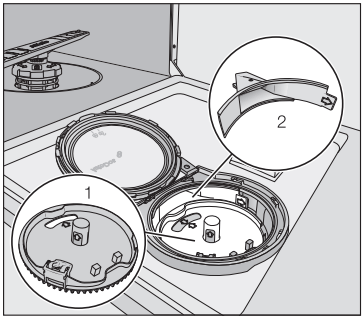
1 PowerDisk holder
2 Fill channel for dispensing the detergent from the PowerDisk into the wash cabinet
- Turn the AutoDos lid to
 and open it.
and open it. - Remove the PowerDisk if appropriate.
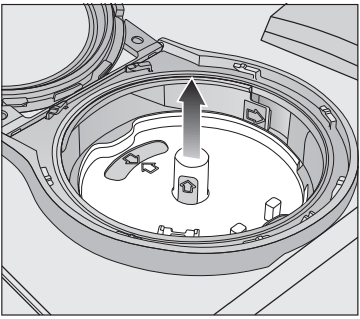
- Pull the PowerDisk holder upward by the yellow tabs and remove it. When doing so, do not pull on the side tab.
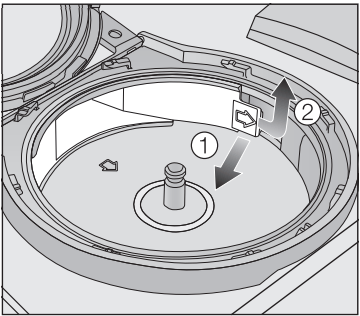
- Use the tab (see the arrow)
 to release the fill channel and pull it out
to release the fill channel and pull it out  .
. - Clean the fill channel using water and a soft brush if necessary.
It is very important that no moisture is able to access the inside of the AutoDos system during cleaning.- Dry the fill channel well so that the detergent powder does not clump together.
- Insert the fill channel again until the tab clicks into place.
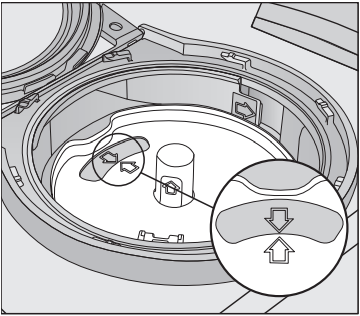
- Put the holder back into place so that the arrows in the PowerDisk holder and in the viewing window point toward each other. The holder must lie flat.
The AutoDos lid must close tightly so that the detergent powder does not get wet and clump together.
Make sure that all seals are clean.- Insert a PowerDisk.
- Close the AutoDos lid and turn it until the lid handle is directly below the
 symbol (see “Inserting a PowerDisk” under “Detergent”).
symbol (see “Inserting a PowerDisk” under “Detergent”).
Regularly check the lower spray arm for any blockages to ensure that the detergent outlet of the AutoDos can be fully flushed out (see “Cleaning the spray arms” under “Cleaning and care”).Checking the filters in the wash cabinet
The filter combination in the base of the wash cabinet retains coarse soil from the suds solution. This prevents soiling getting into the circulation system and re-entering the wash cabinet through the spray arms.
Damage due to soiling entering the circulation system.
Without filters, soiling can enter the circulation system and cause a blockage.
Do not run a wash program without the lower spray arm or without the filters.
When cleaning the filters and spray arms, make sure that coarse soiling cannot get into the circulation system.The filters can become blocked by soiling that collects over time. The level of soiling and time it takes before the filters need cleaning will vary depending on use.
The message Check filters will appear in the display after every 50 program sequences.
- Check the filter combination.
- Clean if necessary.
- Then confirm the message with OK.
Cleaning the filters
- Turn off the dishwasher.
- Remove the lower spray arm (see “Cleaning the spray arms” under “Cleaning and care”).
- Before removing the filter combination, remove any coarse soiling to prevent it from entering the circulation system.
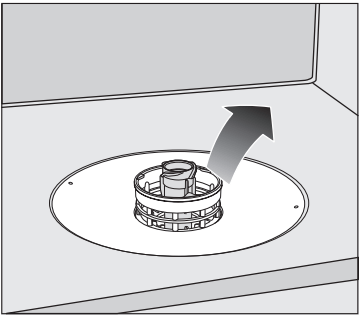
- Remove the filter combination.

- In order to clean the inside of the filter, pull the microfilter on the plastic ring downwards and away from the filter combination.
- Rinse all of the filters under running water. If necessary, use a soft cleaning brush to remove soiling.
- Insert the microfilter back into the filter combination.
- Reinstall the filter combination so that it lies flat in the base of the wash cabinet.
- Refit the lower spray arm to the filter combination using the screw thread.
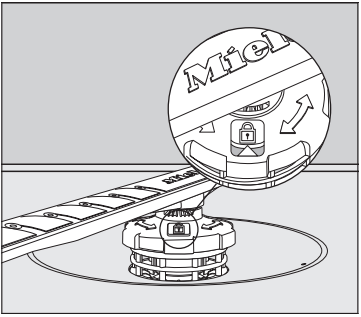
- Rotate the screw thread clockwise until the arrow in the viewing window points to the lock symbol
 .
.
Damage due to soiling entering the circulation system.
The lower spray arm is used to secure the filter combination. Without filters, coarse soiling can enter the circulation system and cause a blockage.
Do not run a wash program without the lower spray arm or without the filters.Cleaning the drain pump
If water remains in the wash cabinet after the end of a program, the water has not been pumped away. The drain pump may be blocked by foreign objects. These foreign objects are easy to remove.
- Disconnect the dishwasher from the power supply. To do this, turn off at the electrical socket and withdraw the plug.
- Take the filter combination out of the wash cabinet (see “Cleaning the filters” under “Cleaning and care”).
- Scoop the water out of the wash cabinet using a suitable small container or utensil.
Frequently asked questions
Many malfunctions and faults that can occur in daily operation can be easily remedied. You can save time and money in many cases, as you do not need to contact Miele Customer Service.
The following tables are designed to help you to find the cause of a malfunction or a fault and to resolve it.
This section only lists faults that you can remedy yourself. All other faults are shown in  Fault FXX.
Fault FXX.
Technical faults | |
Problem | Possible cause and solution |
The dishwasher does not start. | The door is not properly closed. ■ Raise the door upward until the catch engages. The dishwasher is not plugged in. ■ Insert the plug. The circuit breaker has tripped. ■ Reset the breaker (see data plate for the correct fuse rating). ■ If the breaker trips again, contact Miele Customer Service. The dishwasher is not turned on. ■ Turn the dishwasher on using the 0 sensor button. |
The dishwasher stops during a program. | The circuit breaker has tripped. ■ Reset the circuit breaker (see data plate for the correct fuse rating). ■ If the circuit breaker trips again, contact Miele Customer Service. |
After the program has started, the in-operation indicator light is not visible. | The reflector panel was not correctly fitted. ■ Re-fit the reflector panel correctly (see installation sheet). |
Fault messages | |
Problem | Possible cause and solution |
The in-operation indicator light is flashing quickly. The alarm tone is sounding. One of the following faults appears in the display: | Before remedying the fault: ■ Turn off the dishwasher. |
| There may be a technical fault. ■ Turn the dishwasher back on after a few seconds. ■ Select the desired program. ■ Close the door. If the fault message appears again, there is a technical fault. ■ Turn off the dishwasher. ■ Turn off the water supply. ■ Contact Miele Customer Service. |
 Waterproof Waterproof | The Waterproof system has reacted. ■ Turn off the dishwasher. ■ Turn off the water supply. ■ Contact Miele Customer Service. |
| Circulation pump fault. ■ Turn off the dishwasher. ■ Turn the dishwasher back on. ■ Select the desired program. ■ Close the door. If the fault message appears again, there is a technical fault. ■ Turn off the dishwasher. ■ Turn off the water supply. ■ Contact Miele Customer Service. |
Door release
Problem | Possible cause and solution |
The in-operation indicator light is flashing quickly. The alarm tone is sounding. The following fault is indicated via the display: | Before remedying the fault: ■ Turn off the dishwasher. |
| The door does not open automatically. There may be a technical fault. ■ Open the door manually (see “Opening the door” under “Before using for the first time”) and turn the dishwasher back on again. ■ If the same fault message appears again, contact Miele Customer Service. The door locking pins do not retract after the door is opened. There may be a technical fault. ■ Turn the dishwasher back on. ■ If the same fault message appears again, contact Miele Customer Service. |
Water intake fault | |
Problem | Possible cause and solution |
The in-operation indicator light is flashing quickly. The alarm tone is sounding. One of the following messages appears in the display: |
|
| The water supply is turned off. ■ Open the shut-off valve all the way. |
| Before remedying the fault: ■ Turn off the dishwasher. Water-intake fault. ■ Open the shut-off valve all the way and start the program again. ■ Clean the water-intake filter (see “Cleaning the water-intake filter” under “Cleaning and care”). ■ The water-connection pressure is lower than 7.25 psi (50 kPa). Seek professional advice. ■ The on-site connection for the water drainage may be too low and you will need to vent the water drainage (see “Water drainage” under “Installation”). |
| A technical fault has occurred. ■ Turn off the dishwasher. ■ Close the shut-off valve. ■ Contact Miele Customer Service. |
The following fault message appears during the EnergySaver program: Intake temperture low | The intake water has not reached the required temperature of 115 °F (45 °C) (see “Water intake” under “Installation”). ■ Start the program again. ■ If the fault message appears again, select a different program. |
The in-operation indicator light is flashing quickly. The alarm tone is sounding. The following message appears on the display: | Before remedying the fault: ■ Turn off the dishwasher. Water drainage fault. There might be water in the wash cabinet. ■ Clean the filter combination (see “Cleaning the filters” under “Cleaning and care”). ■ Clean the drain pump (see “Cleaning the drain pump” under “Cleaning and care”). ■ Remove any kink or loop in the drain hose. |
Fault in the AutoDos (automatic dispensing)
Problem | Possible cause and solution |
The following message appears on the display: Insert PowerDisk or deactivate AutoDos with OK | The ■ Insert a PowerDisk (see “Automatic dispensing/ AutoDos” under “Detergent”). ■ If you do not wish to use AutoDos, deactivate the function using OK or the |
The in-operation indicator light is flashing quickly. The alarm tone is sounding. The program does not start or a program that has already started stops. The following message appears on the display: AutoDos lid open | The AutoDos lid has not been closed properly. ■ Close the AutoDos lid and lock it fully (see “Automatic dispensing/AutoDos” under “Detergent”). ■ If the lid cannot be fully closed, check whether the PowerDisk holder is lying flat (see “Inserting a PowerDisk” under “Detergent”). ■ If the same fault message appears again, contact Miele Technical Service. |
The following message appears on the display: PowerDisk empty. Deactivate AutoDos with OK. | The ■Replace the PowerDisk (see “Automatic dispensing/AutoDos” under “Detergent”). If you do not wish to use AutoDos, deactivate the function using OK or the |
The message PowerDisk empty. Deactivate AutoDos with OK. appears in the display even though you have inserted a new Pow-erDisk. | The dishwasher was turned off when the PowerDisk was replaced and it has therefore not recognized the new PowerDisk. ■ Turn the dishwasher on before replacing the PowerDisk (see “Automatic dispensing/AutoDos” and “Inserting a PowerDisk” under “Detergent”). |
Problem | Possible cause and solution |
The in-operation indicator light is flashing quickly. At the end of the program, the alarm tone sounds and the display shows the following message:
| There is a fault in the AutoDos. ■ Turn the dishwasher off and back on again. ■ Check whether the PowerDisk holder and the PowerDisk have been fitted correctly (see “Automatic dispensing/AutoDos” under “Detergent”). ■ Activate the If the fault message appears again, there is a technical fault. You can continue to use your dishwasher by deactivating automatic dispensing using the ■ If you wish to use automatic dispensing again, contact Miele Customer Service. |
The in-operation indicator light is flashing quickly. At the end of the program, the alarm tone sounds and the display shows the following message: AutoDos maintenance required The dishwasher does not turn off at the end of the program. The dishes may not be clean because an insufficient amount of detergent was dispensed. The | An empty PowerDisk has been inserted or the Auto-Dos is blocked by residual detergent. Detergent dosage is insufficient. The ■ Turn the dishwasher off and back on again. Multiple messages appear in the display. ■ Clean the pouring channel of the AutoDos (see “Cleaning the AutoDos” under “Detergent”). ■ Clean the lower spray arm (see “Cleaning the spray arms” under “Cleaning and care”). ■ Select OK to confirm each message. ■ Activate the ■ Start the program again. The program duration will be extended by up to 2.5 hours to flush out the AutoDos detergent outlet. |
Spray arm fault
Problem | Possible cause and solution |
During the program and at the end of the program, the display shows the following message: Check spray arms The dishwasher does not turn off at the end of the program. The dishes may not be clean because no detergent was dispensed. The | The lower spray arm is blocked or the nozzles of the lower spray arm are clogged. The ■ Turn the dishwasher off and back on again. Messages appear in the display. ■ Perform a rotation check of the lower spray arm and rearrange the wash items if they are blocking the spray arm. ■ Clean the lower spray arm (see “Cleaning the spray arms” under “Cleaning and care”). ■ Select OK to confirm each message. ■ Start the program again. |
General dishwasher problems
Problem | Possible cause and solution |
The in-operation indicator light is flashing quickly. The alarm tone is sounding. The indicator light of the selected program is flashing and the message Continue with OK appears in the display. The dishwasher does not start or the Flex-iTimer stops running. | The safe mode of the dishwasher was activated. This takes place in the following instances: - If you do not close the door within 4 seconds of the last press of a sensor button at program start. - If the door is open for longer than 4 seconds during a program or before the FlexiTimer start time is reached. ■ Press the OK sensor button and close the door within 4 seconds. |
The indicator lights and the display are dark. | The dishwasher has turned off automatically to save energy. ■ Turn the dishwasher back on using the |
The wash cabinet lighting does not come on when the door is opened. | The wash cabinet lighting has been turned off permanently. ■ Turn the lighting back on again (see “BrilliantLight” under “Settings”). Faulty wash cabinet lighting. ■ Contact Miele Customer Service. |
Detergent residue is left in the detergent compartment at the end of a program. | The detergent compartment was still damp when detergent was added. ■ Only add the detergent when the detergent compartment is dry. |
The detergent compartment lid cannot be closed. | Residual detergent is blocking the catch. ■ Remove the residual detergent. |
At the end of a program there is a film of moisture on the inside of the door and possibly on the interior cabinet walls. | This is part of the normal function of the drying system. The moisture will dissipate after a short time. |
Problem | Possible cause and solution |
Water remains in the wash cabinet at the end of a program. | Before remedying the fault: ■ Turn off the dishwasher. |
The filter combination in the wash cabinet is clogged. ■ Clean the filter combination (see “Cleaning the filters” under “Cleaning and care”). | |
The drain pump is blocked. ■ Clean the drain pump (see “Cleaning the drain pump” under “Cleaning and care”). | |
The drain hose is kinked. ■ Remove any kinks from the drain hose. | |
Build-up of odors in the wash cabinet | The frequent use of low-temperature wash programs (< 122°F/50°C) increases the risk of contamination and odors inside the wash cabinet. ■ Regularly run a high-temperature program. This is to prevent contamination and odors. |
Noises
Problem | Possible cause and solution |
There is a knocking noise in the wash cabinet. | A spray arm is knocking against a wash item. ■ Carefully open the door and rearrange the wash items that are obstructing the spray arm. |
There is a rattling noise in the wash cabinet. | Wash items are not secure in the wash cabinet. ■ Carefully open the door and rearrange the wash items so that they sit securely. |
There is a foreign object (e.g., glass shard) in the drain pump. ■ Remove the foreign object from the drain pump (see “Cleaning the drain pump” under “Cleaning and care”). | |
Knocking noise in the water pipes | This may be caused by the on-site installation or the cross-section of the piping. ■ However, this will not affect the functioning of the dishwasher in any way. If in doubt, contact a suitably qualified plumber. |
Poor cleaning results
Problem | Possible cause and solution |
The dishware is not clean. | The dishware was not loaded correctly. ■ See notes under “Loading the dishwasher”. The program was not powerful enough. ■ Select a more powerful program (see “Program overview”). ■ Activate the Extra clean function (see “Extra clean” under “Settings”). ■ Activate the “Second interim rinse” function (see “Settings - Second interim rinse”). Not enough detergent was dispensed. ■ Use more detergent during manual dispensing or change the detergent you are using. ■ Increase the dispensing quantity during automatic dispensing (if available) (see “Settings - AutoDos”). Items are blocking the path of the spray arms. ■ Carry out a rotation check and if needed rearrange the items so that the spray arms can rotate freely. The filter combination in the wash cabinet is not clean or was incorrectly installed. This may have caused the spray-arm jets to become blocked. ■ Clean and/or install the filter combination correctly. ■ Clean the spray-arm jets if necessary (see “Cleaning the spray arms” under “Cleaning and care”). |
There are smears on glassware and cutlery. There is a bluish sheen on the surface of glassware. The film can be wiped off. | The rinse aid dosage is set too high. ■ Reduce the dosage (see “Rinse aid” under “Settings”). |
Problem | Possible cause and solution |
The dishware is not dry or utensils and glasses are flecked. | The rinse-aid dosage is set too low or the rinse-aid reservoir is empty. ■ Replenish the reservoir, increase the dosage, or change the brand of rinse aid (see “Rinse aid” under “Before using for the first time”). |
The dishware was taken out of the wash cabinet too soon. ■ Leave the dishware in longer (see “Unloading the dishwasher” under “Operation”). | |
The duration of the drying phase for the selected program is not sufficient for the dishware (particularly for plastic dishware). ■ Select the Extra Dry function (see “Extra Dry” under “Settings”). | |
You have used combination products that have insufficient drying performance. ■ Switch to another detergent or replenish the rinse aid (see “Rinse aid” under “Before using for the first time”). | |
Glassware has a brown or blue tinge. The film cannot be wiped off. | Ingredients from the detergent have formed a deposit. ■ Switch to another detergent straight away. |
Glassware is dull and discolored. The film cannot be wiped off. | The glassware is not dishwasher-safe. The surface has altered. ■ No remedy. Purchase glassware which is dishwasher-safe. |
Tea or lipstick stains have not been completely removed. | The wash temperature of the selected program was too low. ■ Select a program with a higher wash temperature. |
The bleaching effect of the detergent is too low. ■ Switch to another detergent. |
Problem | Possible cause and solution |
Plastic parts are discolored. | Natural dyes, e.g., from carrots, tomatoes, or ketchup may be the cause. The amount of detergent used or its bleaching effect was not sufficient to deal with natural dyes. ■ Use more detergent (see “Detergent”). Parts that are already discolored will not revert to their original color. |
White residue is visible on the dishware. Clouding has occurred on glassware and utensils. The film can be wiped off. | The rinse-aid dosage is set too low. ■ Increase the dosage (see “Rinse aid” under “Settings”). |
The salt reservoir is empty. ■ Fill the salt reservoir (see “Reactivation salt” under “Before using for the first time”). | |
The salt-reservoir cap has not been screwed on correctly. ■ Replace it, making sure that it screws back on correctly. | |
Unsuitable combination detergents were used. ■ Switch to another detergent. If using detergent tabs or powder detergent, do not choose combination products and ensure you refill the reactivation salt and rinse aid. | |
The water softener is programmed to too low a water hardness level. ■ Program the water softener to a higher water hardness level (see “Water hardness” under “Settings”). | |
Too much detergent was dispensed. ■ Reduce the dispensing quantity during automatic dispensing (if available) (see “Settings - AutoDos”). ■ Activate the “Second interim rinse” function (see “Settings - Second interim rinse”). | |
Not enough combination detergent was dispensed. The water softener performance is not sufficient. ■ Increase the dispensing quantity during automatic dispensing (if available) (see “Settings - AutoDos”). ■ Add more reactivation salt. |
Problem | Possible cause and solution |
There are rust stains on the cutlery. | The affected items are not corrosion resistant. ■ No remedy. Purchase cutlery which is dishwasher-proof. |
A program was not run after reactivation salt was added. Traces of salt have got into the normal wash cycle. ■ Always run the | |
The salt reservoir cap has not been screwed on correctly. ■ Replace it, making sure that it screws back on correctly. |
See other models: HM16-80 PG 8056 U PG 8130 I [120/240V 60HZ 30A] G 6665 SCVI AM G 7366 SCVI SF AUTODOS

 Drain
Drain AutoDos function is active but no PowerDisk has been inserted.
AutoDos function is active but no PowerDisk has been inserted. Fault F601
Fault F601 AutoDos function is automatically deactivated during the program because the AutoDos detergent outlet cannot be completely flushed out.
AutoDos function is automatically deactivated during the program because the AutoDos detergent outlet cannot be completely flushed out. QuickIntenseWash program with the
QuickIntenseWash program with the  Express program option selected and without any dishes in the dishwasher after adding reactivation salt.
Express program option selected and without any dishes in the dishwasher after adding reactivation salt.